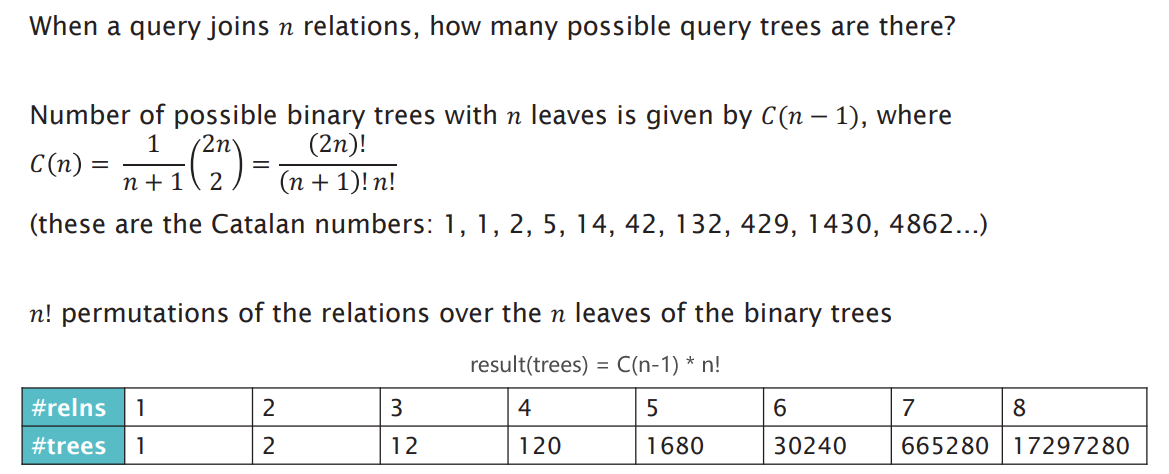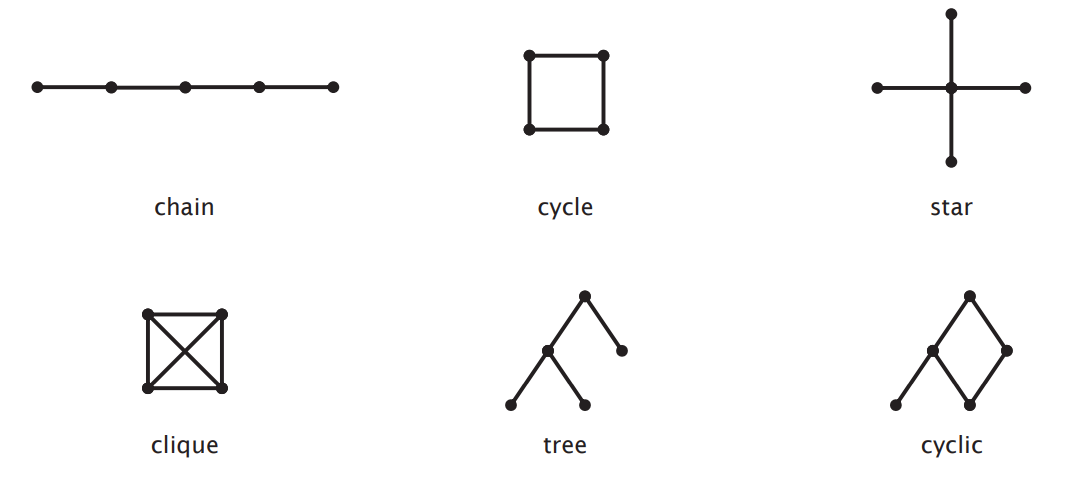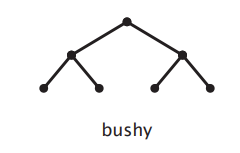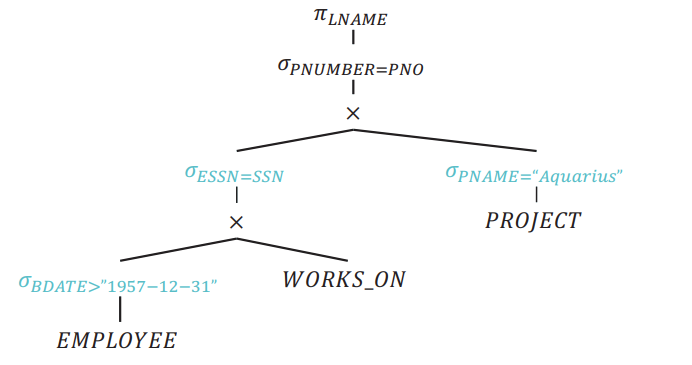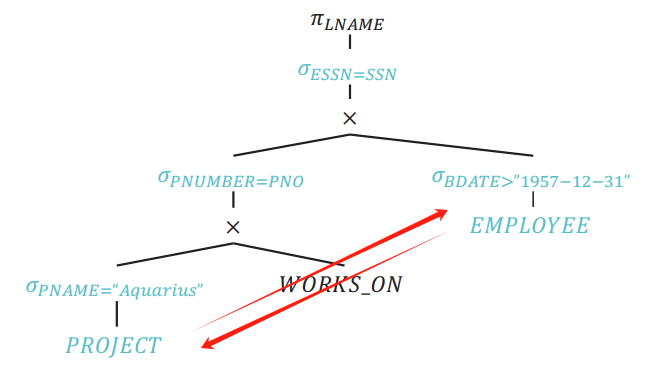In this blog, I will discuss how a database engine optimises a SQL query statement with multiple relations (tables), from the database execution plan perspective.
- How Many Query Trees in a Relational Query?
- Query Graphs
- Optimising Query Trees (Optimised Logical Query Plan)
How Many Query Trees in a Relational Query?
When we know how to do cost estimation, we have a way of determining whether one plan is better than another. Our next step is to compare all possible plans to find the optimal plan.
But here’s the problem: How many possible plans are there?
Considering plans with only × or ⋈, and with n relations:
The Main Determinant of Query Cost: Joining Order
- As above, the number of query trees explodes with increasing of
n(number of relations) - So, in reality, it is impossible to perform an exhaustive search to determiner which query tree is best (which query plan is best).
- Join ordering is the main determiner of query cost
- Need to use Query Graphs to guide search through space of possible join orderings
- Prefer
⋈over×(smaller output relation, which is cheaper)
Query Graphs
Example
- For this example, we consider conjunctive queries with simple predicates only (i.e. predicates of the form
a = bora = 1) - Queries join base relations
R1, R2, ..., Rn, possibly modified by selections - We can construct a query graph for queries of this type
- Undirected graph
- Undirected graphs are used because the connections between relationships are usually bi-directional, which means that the order of the connections can be arbitrary and does not affect the final result. (Join operations don’t care about the order)
- Vertices (
R1, R2, ..., Rn) - Edges (
<R, S>)- A predicate of the form
a = b, wherea ∈ R1andb ∈ R2, gives an edge<R1, R2> - A predicate of the form
a = 1, wherea ∈ R1, gives an edge<R1, R1>
- A predicate of the form
- Undirected graph
Assuming, we have the following 3 tables:
1
2
3
SELECT PNUMBER, DNUM, LNAME, ADDRESS, DATE
FROM PROJECT, DEPARTMENT, EMPLOYEE
WHERE DNUM=DNUMBER AND MGRSSN=SSN AND PLOCATION='Stafford'
For the above SQL, we can get the following undirected graph:
Different Query Graphs
- Different query graph structures serve specific use cases:
- Chain: When a query involves several tables, and each table is joined only with the previous and/or next table in the chain, a chain structure is formed.
- Cycle: A cycle structure emerges in a query graph when the join conditions create a closed loop among the tables. This means that starting from one table, you can follow the join conditions through a series of tables and eventually return to the starting table.
- Star: When there is a central fact table surrounded by multiple dimension tables connected to it, a star structure is formed. This is common in star schema data warehouses.
- Clique: When a query requires multiple tables and each table must be joined with every other table, a clique structure is formed. This typically occurs in query designs that require a full join among multiple tables.
- Tree: When a query can be executed without forming any cycles, meaning no table needs to be joined twice, a tree structure is formed.
- Cyclic: When the join relations in a query contain cycles, a cyclic structure is formed. This might require more optimization to reduce the cost of the query.
- They can help us exclude join orderings that would lead to cross products (Cross products/joins, which is
×, means that every row in two tables matches every row in another table once, resulting in a result set whose size is the product of the number of rows in the two tables. Cross products/joins tend to be very inefficient because they generate a lot of unnecessary data).
Join Trees
- Choice of join tree shapes also constrains search space
- Two main classes of join tree
- Linear (left-deep, right-deep, zig-zag)
- Bushy
- Choice depends on:
- Algorithms chosen (i.e. physical plan operators)
- Execution model
Linear Join Trees
- Every join introduces at least one base relation
- Better for pipelining - avoids materialisation
- Possible left-deep trees:
n! - Possible right-deep trees:
n! - Possible zig-zag trees:
n! * 2^(n-2)
Bushy Join Trees
- Some joins may not join any base relations
- Need not be balanced
- Better for parallel processing
- Possible bushy trees:
n! * C(n-1) = (2n)!/n! - Linear Join Trees is a special type of Bushy Join Trees
Optimising Query Trees (Optimised Logical Query Plan)
Optimisation Approaches
- Wide variety of approaches (no single best approach)
- Heuristic: transformation rules, keep transformed plan if cheaper
- Start with canonical form
- Push
σoperators down the tree - Introduce joins (combine
×andσto create⋈) - Determine join order
- Push
πoperators down the tree
- Dynamic programming
- Randomised: avoid local minima by randomly jumping within big search spaces
- …
- Heuristic: transformation rules, keep transformed plan if cheaper
Example (Heuristic)
Transforms into Left-Deep Tree
- Query trees should be:
- Useful to only consider left-deep trees (Left-deep trees are easier to translate into efficient execution plans, because the database query optimiser executes the leftmost table joins first)
- Fewer possible left-deep trees than possible bushy trees (smaller search space when investigating join orderings)
- Left deep trees work well with common join algorithms (nested-loop, index, one-pass, …)
- Canonical form should be:
- a left-deep tree of products with
- a conjunctive selection above the products and
- a projection (of the output attributes) above the selection
 Transforms into left-deep tree
Transforms into left-deep tree
Move σ down
- According to Relational Transformations
σ p∧q∧r (R) = σp(σq(σr(R)))andσp(σq(R)) = σq(σp(R)):- A selection of the form
σ (a = 1)can be pushed down to just above the relation that containsa - A selection of the form
σ (a = b)can be pushed down to the product above the subtree containing the relations that containaandb
- A selection of the form
Reorder Joins
- If a query joins
nrelations and we restrict ourselves only to left-deep trees, there aren!possible join orderings- Far more possible orderings if we don’t restrict to left-deep
- For simplicity of search, adopt a greedy approach:
- Reorder subtrees to put the most restrictive relations (fewest tuples) first
Assuming that tuples of PNAME = "Aquarius" is less than BDATE > "1957-12-31":
Combine Products to Create joins
- According to Relational Transformations
σp(R⨉S) = R ⨝p S:- Combine
×with adjacentσto form⋈ - Much cheaper than product followed by selection (eliminating a lot of unnecessary data)
- Combine
 Combine Products to Create joins
Combine Products to Create joins
Move π down
If intermediate relations are to be kept in buffers (i.e. materialised), reducing the degree of those relations (number of attributes) allows us to use fewer buffer frames。





